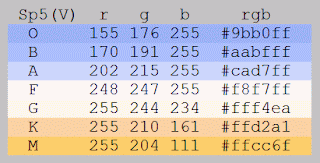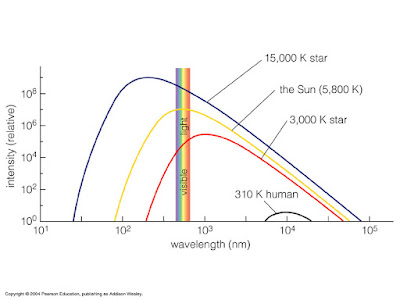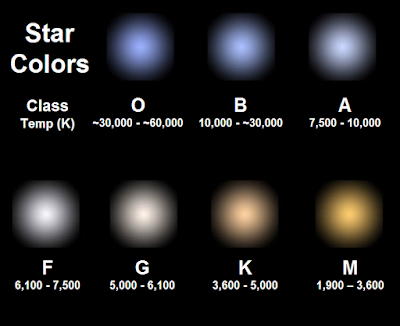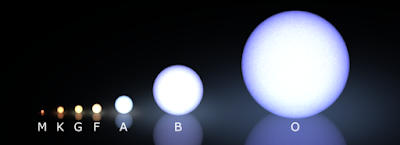Yesterday's post included a frame from a video showing a simulation of a yellow-and-orange double star. I got to wondering how accurate the colors are. Spelunking about on the Web I located Mitchell Charity's Star Colors page, which includes this table:
 The colors shown are for the mid-Class stars, O5, B5 and so forth. In particular, an "earlier" O star such as O2 will be a bit bluer than the top row, and a "late" M star such as M8 will be quite a bit closer to red-orange (█), the color of a "red hot" object such as the burner of an electric stove turned all the way up.
The colors shown are for the mid-Class stars, O5, B5 and so forth. In particular, an "earlier" O star such as O2 will be a bit bluer than the top row, and a "late" M star such as M8 will be quite a bit closer to red-orange (█), the color of a "red hot" object such as the burner of an electric stove turned all the way up.Note also that these are the colors we see looking through a telescope, and particularly if we defocus the stars a little so they are colored disks. In other words, these are the colors as seen through the atmosphere. The air in a clear sky scatters about 30% of the light before it reaches the ground, and it scatters nine times as much blue light as red, meaning that the light that comes direct to you has already been reddened by having a lot of the blue removed, but only a little of the redder light. That is why the Sun is considered a yellowish star.
The total light from our sky, particularly on a somewhat overcast day, is the whitest white the eye can see. Our eyes evolved to take maximum advantage of the light our star emits, so that light is, by definition, White. Viewed from outside the atmosphere, any particular star would appear a little bluer than it does from Earth's surface.
 This chart shows idealized spectra of stars of a few temperatures, plus the infrared spectrum emitted by a human body (98.6°F = 37.0°C = 310K). 15,000K is the temperature of a mid-Class B star and 3,000K is that of an early M star.
This chart shows idealized spectra of stars of a few temperatures, plus the infrared spectrum emitted by a human body (98.6°F = 37.0°C = 310K). 15,000K is the temperature of a mid-Class B star and 3,000K is that of an early M star.The B star emits three times as much blue as red, while the M star emits almost nine times as much red as blue. But at 3,000K it is still almost 500° hotter than the filament of an incandescent light bulb, which looks white to us when we are indoors. But if you are outside on a cloudy day and see a lighted room through the window, it looks orangeish, just like the "M" row on the table above. That is because your reference for white is now the sky, which is the exact color of the Sun, just spread around by the scattering in the clouds.
 Here is a graphic of the appearance of stars of different temperatures, rendered to the same total intensity. I re-drafted the text because the original image used Fahrenheit temperatures. Kelvins are the appropriate units for temperatures higher than a few hundred degrees.
Here is a graphic of the appearance of stars of different temperatures, rendered to the same total intensity. I re-drafted the text because the original image used Fahrenheit temperatures. Kelvins are the appropriate units for temperatures higher than a few hundred degrees.It would take quite a set of neutral density filters to get actual stars of these classes to have such similar intensities. An O star is about a million times as bright as a G star, and a G star is hundreds to thousands of times as bright as an M star.
Most of the bright stars you see in the night sky are B and A, and thus bluish in color. Thus, they "tune" your eyesight to that as the reference white, so when you look at Antares or Betelgeuse, they look quite reddish. In reality, both of those "red" are pale yellowish orange, a thousand degrees hotter and thus somewhat whiter than an incandescent bulb (or a "warm white" CFL).
 Finally, this image from Wikimedia Commons gives a better idea of the sizes and colors of Main Sequence stars of the different Classes. O and B stars are called Main Sequence giants and the rest are called dwarfs (The visually brightest star, Sirius, is a dwarf of Class A, though it is almost three times as large as the Sun). Even an O giant, however, is much smaller than a red giant, which is a very expanded main sequence star in the helium-burning stage.
Finally, this image from Wikimedia Commons gives a better idea of the sizes and colors of Main Sequence stars of the different Classes. O and B stars are called Main Sequence giants and the rest are called dwarfs (The visually brightest star, Sirius, is a dwarf of Class A, though it is almost three times as large as the Sun). Even an O giant, however, is much smaller than a red giant, which is a very expanded main sequence star in the helium-burning stage.Try this sometime, when you have a telescope available, perhaps at a star party. Look at a rich open cluster such as the Perseus Double Cluster, and then defocus the eyepiece a little so the stars are small disks. Among the mostly whitish dots, a few will be bluer, and several will be yellow or orange. With a little thought (and the table above), you'll be able to estimate the temperature of each star.



No comments:
Post a Comment